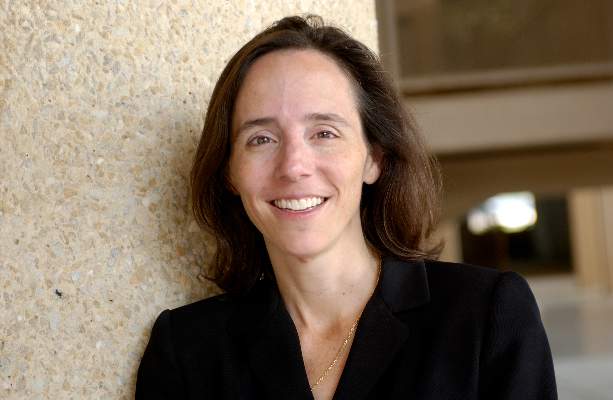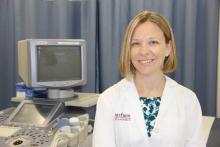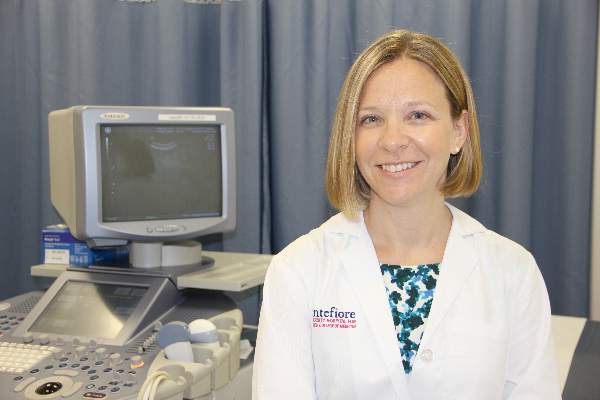User login
What does the Human Placenta Project mean for obstetrics care?
Earlier this year, officials at the National Institutes of Health launched the Human Placenta Project with the aim of better understanding how this organ functions and what role it plays in adverse pregnancy outcomes from preeclampsia to preterm birth.
One of the main goals of the project is to develop new technologies for the real-time assessment of placental development, allowing for the study of placental function in normal versus abnormal pregnancies. NIH officials also seek to develop noninvasive markers to predict adverse pregnancy outcomes and better understand how the placenta affects long-term health. In late September, the agency took a step toward those goals by awarding $46 million to researchers around the country.
What does this mean for obstetrics care? In an interview, Dr. Catherine Y. Spong, a maternal-fetal medicine specialist and deputy director of the NIH’s Eunice Kennedy Shriver National Institute of Child Health and Human Development, Rockville, Md., explained how this initiative is different from studying the placenta after birth, as well as when this research could yield clinically meaningful results.
Question: Through the project, you’re setting out to study the human placenta in real time. What will that tell us that looking at the placenta at birth alone does not?
Dr. Spong: Just as the fetus develops and changes across pregnancy, the placenta does as well. Early on, the placenta invades into the uterine decidua, invades the spiral arteries, and replaces the endothelium to make the vessels large bore, for easy flow of blood to the fetus. If this does not happen, preeclampsia may develop and the fetus may not grow appropriately.
Using current methods of evaluating the placenta after delivery does not help us determine how the placenta is working or functioning early or in mid-gestation. It is akin to doing an autopsy at the end of life and trying to figure out how the person developed and acted during their youth and midlife.
Our hope is that by monitoring the placenta in action, we will gain a much richer understanding of normal placental function – and of placental problems that can lead to common pregnancy complications.
Question: What could this research potentially tell us about hard-to-prevent conditions such as preterm birth and other adverse pregnancy outcomes?
Dr. Spong: Preterm birth and adverse pregnancy outcomes have as one component abnormal placental function. If the placenta cannot support the pregnancy, the baby may not grow well and may develop growth restriction. The placenta, if not formed appropriately, also may result in preeclampsia (toxemia), stillbirth, or preterm birth. If we could better understand how the placenta develops and functions in healthy pregnancies, we may be able to spot potential problems earlier on and test interventions to see if they improve outcome.
Question: How will environmental impacts on pregnancy be monitored through the placenta?
Dr. Spong: It is clear that environmental influences affect outcomes. One of the initiatives we are supporting will help to evaluate how these influences affect outcome. Investigators will study factors such as smoking or obesity, thus including women who do and who do not have these influences, and determine how they affect placental development.
Question: The NIH is investing more than $40 million in this project. How will the money be spent?
Dr. Spong: Our funds will support development of novel approaches for placental assessment, research on environmental influences that affect placental structure and function, and interdisciplinary collaborations, including investigators new to placental research who bring important expertise in bioimaging and biotechnology.
We have been impressed by the proposals we have received, both in their quality and breadth. Investigators are focusing on a range of imaging technologies, including MRIs and ultrasound, as well as techniques to identify biomarkers of placental function in maternal blood samples. Investigators also are interested in many different environmental factors, from nutrition to air pollution.
This initial investment in the Human Placenta Project should lead to new approaches to safe, noninvasive, real-time monitoring of placental development and function across pregnancy, and yield important insights into environmental influences on placental health.
Question: It takes a while for research findings to translate into clinical practice. How long before ob.gyns. can see practice-changing recommendations as a result of this project?
Dr. Spong: This is an important question, as not only do we need the evidence to determine what is important for normal placental development and function, but we also need to learn what additional steps to take to optimize pregnancy outcome. The timing for this – both identifying the development, structure, and function of the placenta across human gestation and determining how best to intervene and optimize outcome – may take some time. However, we believe that this work will be time well spent. It is clear that pregnancy affects the lifelong health of both the mom and the fetus. If we could optimize pregnancy outcome, we could improve the health of the nation.
Find more information on the NIH’s Human Placenta Project here.
mschneider@frontlinemedcom.com
On Twitter @maryellenny
Earlier this year, officials at the National Institutes of Health launched the Human Placenta Project with the aim of better understanding how this organ functions and what role it plays in adverse pregnancy outcomes from preeclampsia to preterm birth.
One of the main goals of the project is to develop new technologies for the real-time assessment of placental development, allowing for the study of placental function in normal versus abnormal pregnancies. NIH officials also seek to develop noninvasive markers to predict adverse pregnancy outcomes and better understand how the placenta affects long-term health. In late September, the agency took a step toward those goals by awarding $46 million to researchers around the country.
What does this mean for obstetrics care? In an interview, Dr. Catherine Y. Spong, a maternal-fetal medicine specialist and deputy director of the NIH’s Eunice Kennedy Shriver National Institute of Child Health and Human Development, Rockville, Md., explained how this initiative is different from studying the placenta after birth, as well as when this research could yield clinically meaningful results.
Question: Through the project, you’re setting out to study the human placenta in real time. What will that tell us that looking at the placenta at birth alone does not?
Dr. Spong: Just as the fetus develops and changes across pregnancy, the placenta does as well. Early on, the placenta invades into the uterine decidua, invades the spiral arteries, and replaces the endothelium to make the vessels large bore, for easy flow of blood to the fetus. If this does not happen, preeclampsia may develop and the fetus may not grow appropriately.
Using current methods of evaluating the placenta after delivery does not help us determine how the placenta is working or functioning early or in mid-gestation. It is akin to doing an autopsy at the end of life and trying to figure out how the person developed and acted during their youth and midlife.
Our hope is that by monitoring the placenta in action, we will gain a much richer understanding of normal placental function – and of placental problems that can lead to common pregnancy complications.
Question: What could this research potentially tell us about hard-to-prevent conditions such as preterm birth and other adverse pregnancy outcomes?
Dr. Spong: Preterm birth and adverse pregnancy outcomes have as one component abnormal placental function. If the placenta cannot support the pregnancy, the baby may not grow well and may develop growth restriction. The placenta, if not formed appropriately, also may result in preeclampsia (toxemia), stillbirth, or preterm birth. If we could better understand how the placenta develops and functions in healthy pregnancies, we may be able to spot potential problems earlier on and test interventions to see if they improve outcome.
Question: How will environmental impacts on pregnancy be monitored through the placenta?
Dr. Spong: It is clear that environmental influences affect outcomes. One of the initiatives we are supporting will help to evaluate how these influences affect outcome. Investigators will study factors such as smoking or obesity, thus including women who do and who do not have these influences, and determine how they affect placental development.
Question: The NIH is investing more than $40 million in this project. How will the money be spent?
Dr. Spong: Our funds will support development of novel approaches for placental assessment, research on environmental influences that affect placental structure and function, and interdisciplinary collaborations, including investigators new to placental research who bring important expertise in bioimaging and biotechnology.
We have been impressed by the proposals we have received, both in their quality and breadth. Investigators are focusing on a range of imaging technologies, including MRIs and ultrasound, as well as techniques to identify biomarkers of placental function in maternal blood samples. Investigators also are interested in many different environmental factors, from nutrition to air pollution.
This initial investment in the Human Placenta Project should lead to new approaches to safe, noninvasive, real-time monitoring of placental development and function across pregnancy, and yield important insights into environmental influences on placental health.
Question: It takes a while for research findings to translate into clinical practice. How long before ob.gyns. can see practice-changing recommendations as a result of this project?
Dr. Spong: This is an important question, as not only do we need the evidence to determine what is important for normal placental development and function, but we also need to learn what additional steps to take to optimize pregnancy outcome. The timing for this – both identifying the development, structure, and function of the placenta across human gestation and determining how best to intervene and optimize outcome – may take some time. However, we believe that this work will be time well spent. It is clear that pregnancy affects the lifelong health of both the mom and the fetus. If we could optimize pregnancy outcome, we could improve the health of the nation.
Find more information on the NIH’s Human Placenta Project here.
mschneider@frontlinemedcom.com
On Twitter @maryellenny
Earlier this year, officials at the National Institutes of Health launched the Human Placenta Project with the aim of better understanding how this organ functions and what role it plays in adverse pregnancy outcomes from preeclampsia to preterm birth.
One of the main goals of the project is to develop new technologies for the real-time assessment of placental development, allowing for the study of placental function in normal versus abnormal pregnancies. NIH officials also seek to develop noninvasive markers to predict adverse pregnancy outcomes and better understand how the placenta affects long-term health. In late September, the agency took a step toward those goals by awarding $46 million to researchers around the country.
What does this mean for obstetrics care? In an interview, Dr. Catherine Y. Spong, a maternal-fetal medicine specialist and deputy director of the NIH’s Eunice Kennedy Shriver National Institute of Child Health and Human Development, Rockville, Md., explained how this initiative is different from studying the placenta after birth, as well as when this research could yield clinically meaningful results.
Question: Through the project, you’re setting out to study the human placenta in real time. What will that tell us that looking at the placenta at birth alone does not?
Dr. Spong: Just as the fetus develops and changes across pregnancy, the placenta does as well. Early on, the placenta invades into the uterine decidua, invades the spiral arteries, and replaces the endothelium to make the vessels large bore, for easy flow of blood to the fetus. If this does not happen, preeclampsia may develop and the fetus may not grow appropriately.
Using current methods of evaluating the placenta after delivery does not help us determine how the placenta is working or functioning early or in mid-gestation. It is akin to doing an autopsy at the end of life and trying to figure out how the person developed and acted during their youth and midlife.
Our hope is that by monitoring the placenta in action, we will gain a much richer understanding of normal placental function – and of placental problems that can lead to common pregnancy complications.
Question: What could this research potentially tell us about hard-to-prevent conditions such as preterm birth and other adverse pregnancy outcomes?
Dr. Spong: Preterm birth and adverse pregnancy outcomes have as one component abnormal placental function. If the placenta cannot support the pregnancy, the baby may not grow well and may develop growth restriction. The placenta, if not formed appropriately, also may result in preeclampsia (toxemia), stillbirth, or preterm birth. If we could better understand how the placenta develops and functions in healthy pregnancies, we may be able to spot potential problems earlier on and test interventions to see if they improve outcome.
Question: How will environmental impacts on pregnancy be monitored through the placenta?
Dr. Spong: It is clear that environmental influences affect outcomes. One of the initiatives we are supporting will help to evaluate how these influences affect outcome. Investigators will study factors such as smoking or obesity, thus including women who do and who do not have these influences, and determine how they affect placental development.
Question: The NIH is investing more than $40 million in this project. How will the money be spent?
Dr. Spong: Our funds will support development of novel approaches for placental assessment, research on environmental influences that affect placental structure and function, and interdisciplinary collaborations, including investigators new to placental research who bring important expertise in bioimaging and biotechnology.
We have been impressed by the proposals we have received, both in their quality and breadth. Investigators are focusing on a range of imaging technologies, including MRIs and ultrasound, as well as techniques to identify biomarkers of placental function in maternal blood samples. Investigators also are interested in many different environmental factors, from nutrition to air pollution.
This initial investment in the Human Placenta Project should lead to new approaches to safe, noninvasive, real-time monitoring of placental development and function across pregnancy, and yield important insights into environmental influences on placental health.
Question: It takes a while for research findings to translate into clinical practice. How long before ob.gyns. can see practice-changing recommendations as a result of this project?
Dr. Spong: This is an important question, as not only do we need the evidence to determine what is important for normal placental development and function, but we also need to learn what additional steps to take to optimize pregnancy outcome. The timing for this – both identifying the development, structure, and function of the placenta across human gestation and determining how best to intervene and optimize outcome – may take some time. However, we believe that this work will be time well spent. It is clear that pregnancy affects the lifelong health of both the mom and the fetus. If we could optimize pregnancy outcome, we could improve the health of the nation.
Find more information on the NIH’s Human Placenta Project here.
mschneider@frontlinemedcom.com
On Twitter @maryellenny
Planned Parenthood gains support from some in medical community
The controversy surrounding the Planned Parenthood Federation of America’s practice of collecting fetal tissue from abortions for medical research continues unabated, but the organization is getting a boost in its political fight from some doctors.
Three Boston-based physicians recently authored an editorial in the New England Journal of Medicine supporting Planned Parenthood and calling the objections to the use of donated fetal tissue for research an excuse to attack the organization.
Dr. George P. Topulos of Brigham and Women’s Hospital, Dr. Michael F. Greene of Massachusetts General Hospital and an associate editor at the journal, and Dr. Jeffrey M. Drazen, editor-in-chief of the journal, called Planned Parenthood’s contraception services possibly the “single greatest effort to prevent the unwanted pregnancies that result in abortion” (doi: 10.1056/NEJMe1510281.).
“We strongly support Planned Parenthood not only for its efforts to channel fetal tissue into important medical research but also for its other work as one of the country’s largest providers of health care for women, especially poor women,” the doctors wrote. “In 2013, the most recent year for which data are available, Planned Parenthood provided services to 2.7 million women, men, and young people during 4.6 million health center visits.”
Dr. Topulos reported that he serves as a volunteer member of the medical committees of both Planned Parenthood League of Massachusetts and Planned Parenthood Federation of America.
Despite the publication of a strong defense of Planned Parenthood in a prominent medical journal, the medical community may be as divided on this issue as Americans generally. Several of the comments on the Aug. 12 editorial came from physicians who blasted Planned Parenthood and the New England Journal of Medicine for publishing the editorial.
The Boston doctors aren’t the only ones taking a public stand in support of Planned Parenthood. In the run-up to a failed attempt in the Senate to strip federal funds from the organization, the American Congress of Obstetricians and Gynecologists, the Society for Maternal-Fetal Medicine, and several other medical societies wrote to congressional leaders, urging them to maintain federal funding for women’s health care through Planned Parenthood.
“Every day, we see the harmful impact that unequal access to health care has on women and communities across the country, and we therefore strongly support policies that improve access to affordable, quality health care. Policies that would deny Planned Parenthood public health funds only serve to cut millions off from critical preventive care, and we strongly oppose any effort to do so,” the groups wrote.
Planned Parenthood still faces scrutiny in Congress. The House Energy and Commerce Committee has begun an investigation into the allegations raised by the anti-abortion group Center for Medical Progress that Planned Parenthood is illegally profiting off the use of fetal tissue in medical research.
On Aug. 7, GOP committee leaders sent letters to Planned Parenthood and three companies that it says either supply or procure fetal tissue. The committee is seeking information on the companies’ practices for collecting fetal tissue, as well as their justification for the prices they charge to researchers and their procedures for ensuring proper informed consent.
mschneider@frontlinemedcom.com
On Twitter @maryellenny
The controversy surrounding the Planned Parenthood Federation of America’s practice of collecting fetal tissue from abortions for medical research continues unabated, but the organization is getting a boost in its political fight from some doctors.
Three Boston-based physicians recently authored an editorial in the New England Journal of Medicine supporting Planned Parenthood and calling the objections to the use of donated fetal tissue for research an excuse to attack the organization.
Dr. George P. Topulos of Brigham and Women’s Hospital, Dr. Michael F. Greene of Massachusetts General Hospital and an associate editor at the journal, and Dr. Jeffrey M. Drazen, editor-in-chief of the journal, called Planned Parenthood’s contraception services possibly the “single greatest effort to prevent the unwanted pregnancies that result in abortion” (doi: 10.1056/NEJMe1510281.).
“We strongly support Planned Parenthood not only for its efforts to channel fetal tissue into important medical research but also for its other work as one of the country’s largest providers of health care for women, especially poor women,” the doctors wrote. “In 2013, the most recent year for which data are available, Planned Parenthood provided services to 2.7 million women, men, and young people during 4.6 million health center visits.”
Dr. Topulos reported that he serves as a volunteer member of the medical committees of both Planned Parenthood League of Massachusetts and Planned Parenthood Federation of America.
Despite the publication of a strong defense of Planned Parenthood in a prominent medical journal, the medical community may be as divided on this issue as Americans generally. Several of the comments on the Aug. 12 editorial came from physicians who blasted Planned Parenthood and the New England Journal of Medicine for publishing the editorial.
The Boston doctors aren’t the only ones taking a public stand in support of Planned Parenthood. In the run-up to a failed attempt in the Senate to strip federal funds from the organization, the American Congress of Obstetricians and Gynecologists, the Society for Maternal-Fetal Medicine, and several other medical societies wrote to congressional leaders, urging them to maintain federal funding for women’s health care through Planned Parenthood.
“Every day, we see the harmful impact that unequal access to health care has on women and communities across the country, and we therefore strongly support policies that improve access to affordable, quality health care. Policies that would deny Planned Parenthood public health funds only serve to cut millions off from critical preventive care, and we strongly oppose any effort to do so,” the groups wrote.
Planned Parenthood still faces scrutiny in Congress. The House Energy and Commerce Committee has begun an investigation into the allegations raised by the anti-abortion group Center for Medical Progress that Planned Parenthood is illegally profiting off the use of fetal tissue in medical research.
On Aug. 7, GOP committee leaders sent letters to Planned Parenthood and three companies that it says either supply or procure fetal tissue. The committee is seeking information on the companies’ practices for collecting fetal tissue, as well as their justification for the prices they charge to researchers and their procedures for ensuring proper informed consent.
mschneider@frontlinemedcom.com
On Twitter @maryellenny
The controversy surrounding the Planned Parenthood Federation of America’s practice of collecting fetal tissue from abortions for medical research continues unabated, but the organization is getting a boost in its political fight from some doctors.
Three Boston-based physicians recently authored an editorial in the New England Journal of Medicine supporting Planned Parenthood and calling the objections to the use of donated fetal tissue for research an excuse to attack the organization.
Dr. George P. Topulos of Brigham and Women’s Hospital, Dr. Michael F. Greene of Massachusetts General Hospital and an associate editor at the journal, and Dr. Jeffrey M. Drazen, editor-in-chief of the journal, called Planned Parenthood’s contraception services possibly the “single greatest effort to prevent the unwanted pregnancies that result in abortion” (doi: 10.1056/NEJMe1510281.).
“We strongly support Planned Parenthood not only for its efforts to channel fetal tissue into important medical research but also for its other work as one of the country’s largest providers of health care for women, especially poor women,” the doctors wrote. “In 2013, the most recent year for which data are available, Planned Parenthood provided services to 2.7 million women, men, and young people during 4.6 million health center visits.”
Dr. Topulos reported that he serves as a volunteer member of the medical committees of both Planned Parenthood League of Massachusetts and Planned Parenthood Federation of America.
Despite the publication of a strong defense of Planned Parenthood in a prominent medical journal, the medical community may be as divided on this issue as Americans generally. Several of the comments on the Aug. 12 editorial came from physicians who blasted Planned Parenthood and the New England Journal of Medicine for publishing the editorial.
The Boston doctors aren’t the only ones taking a public stand in support of Planned Parenthood. In the run-up to a failed attempt in the Senate to strip federal funds from the organization, the American Congress of Obstetricians and Gynecologists, the Society for Maternal-Fetal Medicine, and several other medical societies wrote to congressional leaders, urging them to maintain federal funding for women’s health care through Planned Parenthood.
“Every day, we see the harmful impact that unequal access to health care has on women and communities across the country, and we therefore strongly support policies that improve access to affordable, quality health care. Policies that would deny Planned Parenthood public health funds only serve to cut millions off from critical preventive care, and we strongly oppose any effort to do so,” the groups wrote.
Planned Parenthood still faces scrutiny in Congress. The House Energy and Commerce Committee has begun an investigation into the allegations raised by the anti-abortion group Center for Medical Progress that Planned Parenthood is illegally profiting off the use of fetal tissue in medical research.
On Aug. 7, GOP committee leaders sent letters to Planned Parenthood and three companies that it says either supply or procure fetal tissue. The committee is seeking information on the companies’ practices for collecting fetal tissue, as well as their justification for the prices they charge to researchers and their procedures for ensuring proper informed consent.
mschneider@frontlinemedcom.com
On Twitter @maryellenny
Planned Parenthood video controversy puts funding in jeopardy
More than 20 Republican senators are calling for a vote to strip federal funding from Planned Parenthood clinics across the country following the release of a series of controversial videos.
The Center for Medical Progress – an antiabortion group – has released three undercover videos showing employees of Planned Parenthood discussing the use of fetal tissue from abortions for medical research. The Center for Medical Progress charges that the videos prove that Planned Parenthood is violating federal law by profitting off the sale of fetal tissue. But Planned Parenthood contends that the videos were made secretly and have been “heavily edited.” They also assert that they do not profit off the donation of fetal tissue.
The controversy, which began with the release of the first video in mid-July, prompted a group of more than 20 Republican senators to introduce legislation that would bar federal funding of the Planned Parenthood Federation of America or any of its affiliates. Supporters of the bill (S. 1881) say all funds stripped from Planned Parenthood would be transferred to other organizations that provide health services for women, ensuring that there was no reduction in overall federal funding for women’s health.
Senate Majority Leader Mitch McConnell, (R-Ky.) said the Senate will vote on the bill the week of Aug. 3.
On the House side, the Energy and Commerce Committee has pledged to investigate the claims of illegal fetal tissue sale.
mschneider@frontlinemedcom.com
On Twitter @maryellenny
More than 20 Republican senators are calling for a vote to strip federal funding from Planned Parenthood clinics across the country following the release of a series of controversial videos.
The Center for Medical Progress – an antiabortion group – has released three undercover videos showing employees of Planned Parenthood discussing the use of fetal tissue from abortions for medical research. The Center for Medical Progress charges that the videos prove that Planned Parenthood is violating federal law by profitting off the sale of fetal tissue. But Planned Parenthood contends that the videos were made secretly and have been “heavily edited.” They also assert that they do not profit off the donation of fetal tissue.
The controversy, which began with the release of the first video in mid-July, prompted a group of more than 20 Republican senators to introduce legislation that would bar federal funding of the Planned Parenthood Federation of America or any of its affiliates. Supporters of the bill (S. 1881) say all funds stripped from Planned Parenthood would be transferred to other organizations that provide health services for women, ensuring that there was no reduction in overall federal funding for women’s health.
Senate Majority Leader Mitch McConnell, (R-Ky.) said the Senate will vote on the bill the week of Aug. 3.
On the House side, the Energy and Commerce Committee has pledged to investigate the claims of illegal fetal tissue sale.
mschneider@frontlinemedcom.com
On Twitter @maryellenny
More than 20 Republican senators are calling for a vote to strip federal funding from Planned Parenthood clinics across the country following the release of a series of controversial videos.
The Center for Medical Progress – an antiabortion group – has released three undercover videos showing employees of Planned Parenthood discussing the use of fetal tissue from abortions for medical research. The Center for Medical Progress charges that the videos prove that Planned Parenthood is violating federal law by profitting off the sale of fetal tissue. But Planned Parenthood contends that the videos were made secretly and have been “heavily edited.” They also assert that they do not profit off the donation of fetal tissue.
The controversy, which began with the release of the first video in mid-July, prompted a group of more than 20 Republican senators to introduce legislation that would bar federal funding of the Planned Parenthood Federation of America or any of its affiliates. Supporters of the bill (S. 1881) say all funds stripped from Planned Parenthood would be transferred to other organizations that provide health services for women, ensuring that there was no reduction in overall federal funding for women’s health.
Senate Majority Leader Mitch McConnell, (R-Ky.) said the Senate will vote on the bill the week of Aug. 3.
On the House side, the Energy and Commerce Committee has pledged to investigate the claims of illegal fetal tissue sale.
mschneider@frontlinemedcom.com
On Twitter @maryellenny
Congress to investigate accusations of fetal tissue sales
Planned Parenthood is under fire after a hidden-camera video has surfaced that appears to show a top executive at the organization discussing the sale of fetal tissue and how abortion procedures are sometimes tailored to preserve fetal organs for research.
The House Energy and Commerce Committee is launching an investigation into charges that the group is involved in the illegal sale of fetal body parts for profit.
“This video is abhorrent and rips at the heart,” Chairman Fred Upton (R-Mich.) and other GOP members of the committee wrote in a statement. “The committee will get to the bottom of this appalling situation.”
State-level investigations also are being launched by the governors of Texas and Louisiana.
Planned Parenthood Federation of America (PPFA) disputes the charges, saying that they help patients who want to donate tissue for scientific research with full, appropriate consent from patients and “under the highest ethical and legal standards,” according to a statement from Eric Ferrero, vice president of communications.
“There is no financial benefit for tissue donation for either the patient or for Planned Parenthood,” he said. “In some instances, actual costs, such as the cost to transport tissue to leading research centers, are reimbursed, which is standard across the medical field.”
The video, posted on YouTube, shows a conversation between Dr. Deborah Nucatola, senior director of medical services at PPFA, and two individuals who were posing as employees of a biologics company. In the video, filmed as they were eating lunch, Dr. Nucatola discusses the demand for some fetal tissue for research purposes and how the tissue is retrieved.
The video was made by The Center for Medical Progress, which said that the video is just one part of a 3-year investigation into Planned Parenthood and what it calls “illegal trafficking of aborted fetal parts.” The group alleges that Planned Parenthood is selling fetal tissue in violation of federal law.
Planned Parenthood said the video, which was recorded secretly, was heavily edited and falsely represents their participation in tissue donation programs.
“Similar false accusations have been put forth by opponents of abortion services for decades,” Mr. Ferrero said. “These groups have been widely discredited and their claims fall apart on closer examination, just as they do in this case.”
mschneider@frontlinemedcom.com
On Twitter @maryellenny
Planned Parenthood is under fire after a hidden-camera video has surfaced that appears to show a top executive at the organization discussing the sale of fetal tissue and how abortion procedures are sometimes tailored to preserve fetal organs for research.
The House Energy and Commerce Committee is launching an investigation into charges that the group is involved in the illegal sale of fetal body parts for profit.
“This video is abhorrent and rips at the heart,” Chairman Fred Upton (R-Mich.) and other GOP members of the committee wrote in a statement. “The committee will get to the bottom of this appalling situation.”
State-level investigations also are being launched by the governors of Texas and Louisiana.
Planned Parenthood Federation of America (PPFA) disputes the charges, saying that they help patients who want to donate tissue for scientific research with full, appropriate consent from patients and “under the highest ethical and legal standards,” according to a statement from Eric Ferrero, vice president of communications.
“There is no financial benefit for tissue donation for either the patient or for Planned Parenthood,” he said. “In some instances, actual costs, such as the cost to transport tissue to leading research centers, are reimbursed, which is standard across the medical field.”
The video, posted on YouTube, shows a conversation between Dr. Deborah Nucatola, senior director of medical services at PPFA, and two individuals who were posing as employees of a biologics company. In the video, filmed as they were eating lunch, Dr. Nucatola discusses the demand for some fetal tissue for research purposes and how the tissue is retrieved.
The video was made by The Center for Medical Progress, which said that the video is just one part of a 3-year investigation into Planned Parenthood and what it calls “illegal trafficking of aborted fetal parts.” The group alleges that Planned Parenthood is selling fetal tissue in violation of federal law.
Planned Parenthood said the video, which was recorded secretly, was heavily edited and falsely represents their participation in tissue donation programs.
“Similar false accusations have been put forth by opponents of abortion services for decades,” Mr. Ferrero said. “These groups have been widely discredited and their claims fall apart on closer examination, just as they do in this case.”
mschneider@frontlinemedcom.com
On Twitter @maryellenny
Planned Parenthood is under fire after a hidden-camera video has surfaced that appears to show a top executive at the organization discussing the sale of fetal tissue and how abortion procedures are sometimes tailored to preserve fetal organs for research.
The House Energy and Commerce Committee is launching an investigation into charges that the group is involved in the illegal sale of fetal body parts for profit.
“This video is abhorrent and rips at the heart,” Chairman Fred Upton (R-Mich.) and other GOP members of the committee wrote in a statement. “The committee will get to the bottom of this appalling situation.”
State-level investigations also are being launched by the governors of Texas and Louisiana.
Planned Parenthood Federation of America (PPFA) disputes the charges, saying that they help patients who want to donate tissue for scientific research with full, appropriate consent from patients and “under the highest ethical and legal standards,” according to a statement from Eric Ferrero, vice president of communications.
“There is no financial benefit for tissue donation for either the patient or for Planned Parenthood,” he said. “In some instances, actual costs, such as the cost to transport tissue to leading research centers, are reimbursed, which is standard across the medical field.”
The video, posted on YouTube, shows a conversation between Dr. Deborah Nucatola, senior director of medical services at PPFA, and two individuals who were posing as employees of a biologics company. In the video, filmed as they were eating lunch, Dr. Nucatola discusses the demand for some fetal tissue for research purposes and how the tissue is retrieved.
The video was made by The Center for Medical Progress, which said that the video is just one part of a 3-year investigation into Planned Parenthood and what it calls “illegal trafficking of aborted fetal parts.” The group alleges that Planned Parenthood is selling fetal tissue in violation of federal law.
Planned Parenthood said the video, which was recorded secretly, was heavily edited and falsely represents their participation in tissue donation programs.
“Similar false accusations have been put forth by opponents of abortion services for decades,” Mr. Ferrero said. “These groups have been widely discredited and their claims fall apart on closer examination, just as they do in this case.”
mschneider@frontlinemedcom.com
On Twitter @maryellenny
Medicare Adds HPV Test for Cervical Cancer Screening
Medicare officials have added the human papillomavirus test to its list of covered services for cervical cancer screening.
In a national coverage decision issued on July 9, officials at the Centers for Medicare & Medicaid Services announced that the “evidence is sufficient” to add HPV testing once every 5 years as a preventive service benefit under the Medicare program for asymptomatic women aged 30-65 years in conjunction with the Pap smear test.
Previously Medicare only covered a screening pelvic examination and Pap smear test at 12- and 24-month intervals based on specific risk factors.
The decision has the potential to affect about 5 million women aged 30-65 who are enrolled in the Medicare program, according to a CMS estimate.
In 2012, the U.S. Preventive Services Task Force recommended screening with a combination of Pap smear and HPV testing every 5 years for women aged 30-65 years. The task force recommends against using HPV testing for cervical cancer screening in women younger than age 30.
The American Academy of Family Physicians, which had urged Medicare officials to add the HPV test as a covered option for cervical screening, praised the decision.
“This decision is consistent with the best medical evidence and provides women and their physicians more options for cervical cancer screening,” Dr. Robert L. Wergin, AAFP president, said in a statement.
Medicare officials have added the human papillomavirus test to its list of covered services for cervical cancer screening.
In a national coverage decision issued on July 9, officials at the Centers for Medicare & Medicaid Services announced that the “evidence is sufficient” to add HPV testing once every 5 years as a preventive service benefit under the Medicare program for asymptomatic women aged 30-65 years in conjunction with the Pap smear test.
Previously Medicare only covered a screening pelvic examination and Pap smear test at 12- and 24-month intervals based on specific risk factors.
The decision has the potential to affect about 5 million women aged 30-65 who are enrolled in the Medicare program, according to a CMS estimate.
In 2012, the U.S. Preventive Services Task Force recommended screening with a combination of Pap smear and HPV testing every 5 years for women aged 30-65 years. The task force recommends against using HPV testing for cervical cancer screening in women younger than age 30.
The American Academy of Family Physicians, which had urged Medicare officials to add the HPV test as a covered option for cervical screening, praised the decision.
“This decision is consistent with the best medical evidence and provides women and their physicians more options for cervical cancer screening,” Dr. Robert L. Wergin, AAFP president, said in a statement.
Medicare officials have added the human papillomavirus test to its list of covered services for cervical cancer screening.
In a national coverage decision issued on July 9, officials at the Centers for Medicare & Medicaid Services announced that the “evidence is sufficient” to add HPV testing once every 5 years as a preventive service benefit under the Medicare program for asymptomatic women aged 30-65 years in conjunction with the Pap smear test.
Previously Medicare only covered a screening pelvic examination and Pap smear test at 12- and 24-month intervals based on specific risk factors.
The decision has the potential to affect about 5 million women aged 30-65 who are enrolled in the Medicare program, according to a CMS estimate.
In 2012, the U.S. Preventive Services Task Force recommended screening with a combination of Pap smear and HPV testing every 5 years for women aged 30-65 years. The task force recommends against using HPV testing for cervical cancer screening in women younger than age 30.
The American Academy of Family Physicians, which had urged Medicare officials to add the HPV test as a covered option for cervical screening, praised the decision.
“This decision is consistent with the best medical evidence and provides women and their physicians more options for cervical cancer screening,” Dr. Robert L. Wergin, AAFP president, said in a statement.
Medicare adds HPV test for cervical cancer screening
Medicare officials have added the human papillomavirus test to its list of covered services for cervical cancer screening.
In a national coverage decision issued on July 9, officials at the Centers for Medicare & Medicaid Services announced that the “evidence is sufficient” to add HPV testing once every 5 years as a preventive service benefit under the Medicare program for asymptomatic women aged 30-65 years in conjunction with the Pap smear test.
Previously Medicare only covered a screening pelvic examination and Pap smear test at 12- and 24-month intervals based on specific risk factors.
The decision has the potential to affect about 5 million women aged 30-65 who are enrolled in the Medicare program, according to a CMS estimate.
In 2012, the U.S. Preventive Services Task Force recommended screening with a combination of Pap smear and HPV testing every 5 years for women aged 30-65 years. The task force recommends against using HPV testing for cervical cancer screening in women younger than age 30.
The American Academy of Family Physicians, which had urged Medicare officials to add the HPV test as a covered option for cervical screening, praised the decision.
“This decision is consistent with the best medical evidence and provides women and their physicians more options for cervical cancer screening,” Dr. Robert L. Wergin, AAFP president, said in a statement.
mschneider@frontlinemedcom.com
On Twitter @maryellenny
Medicare officials have added the human papillomavirus test to its list of covered services for cervical cancer screening.
In a national coverage decision issued on July 9, officials at the Centers for Medicare & Medicaid Services announced that the “evidence is sufficient” to add HPV testing once every 5 years as a preventive service benefit under the Medicare program for asymptomatic women aged 30-65 years in conjunction with the Pap smear test.
Previously Medicare only covered a screening pelvic examination and Pap smear test at 12- and 24-month intervals based on specific risk factors.
The decision has the potential to affect about 5 million women aged 30-65 who are enrolled in the Medicare program, according to a CMS estimate.
In 2012, the U.S. Preventive Services Task Force recommended screening with a combination of Pap smear and HPV testing every 5 years for women aged 30-65 years. The task force recommends against using HPV testing for cervical cancer screening in women younger than age 30.
The American Academy of Family Physicians, which had urged Medicare officials to add the HPV test as a covered option for cervical screening, praised the decision.
“This decision is consistent with the best medical evidence and provides women and their physicians more options for cervical cancer screening,” Dr. Robert L. Wergin, AAFP president, said in a statement.
mschneider@frontlinemedcom.com
On Twitter @maryellenny
Medicare officials have added the human papillomavirus test to its list of covered services for cervical cancer screening.
In a national coverage decision issued on July 9, officials at the Centers for Medicare & Medicaid Services announced that the “evidence is sufficient” to add HPV testing once every 5 years as a preventive service benefit under the Medicare program for asymptomatic women aged 30-65 years in conjunction with the Pap smear test.
Previously Medicare only covered a screening pelvic examination and Pap smear test at 12- and 24-month intervals based on specific risk factors.
The decision has the potential to affect about 5 million women aged 30-65 who are enrolled in the Medicare program, according to a CMS estimate.
In 2012, the U.S. Preventive Services Task Force recommended screening with a combination of Pap smear and HPV testing every 5 years for women aged 30-65 years. The task force recommends against using HPV testing for cervical cancer screening in women younger than age 30.
The American Academy of Family Physicians, which had urged Medicare officials to add the HPV test as a covered option for cervical screening, praised the decision.
“This decision is consistent with the best medical evidence and provides women and their physicians more options for cervical cancer screening,” Dr. Robert L. Wergin, AAFP president, said in a statement.
mschneider@frontlinemedcom.com
On Twitter @maryellenny
HHS Finalizes Religious Exemptions in ACA Contraception Mandate
The Obama administration is aiming to give employers with a religious objection an easier way to opt out of providing birth control under the Affordable Care Act, while also preserving no-cost access to contraception for women.
The new procedure, released on July 10, is part of final regulations that also spell out minor changes to the implementation of the ACA’s covered preventive services, which include contraceptive services.
Under the new reporting pathway, nonprofit religious employers and certain closely held for-profit companies with religious objections to providing coverage for contraceptives can write a letter to the US. Department of Health and Human Services stating their objections and desire to opt out. HHS will then notify the insurer about the objection and the insurer becomes responsible for making separate arrangements for women in the plan to receive no-cost contraceptive services.
HHS had offered this alternative pathway to nonprofit religious employers as part of an interim final rule published in August 2014. Previously, religious employers had been required to notify the health plan about religious objections.
Following the 2014 U.S. Supreme Court’s decision in Burwell v. Hobby Lobby Stores, Inc. that extended religious exemptions beyond nonprofit religious employers, HHS issued a proposal to provide the same religious exemptions and reporting options to certain closely held for-profit companies with religious objections to contraception.
The latest final rules were issued jointly by HHS, along with the Departments of Labor and Treasury. HHS Secretary Sylvia Burwell said the regulation strikes the right balance between providing access to contraception and respecting religious views.
Other Democrats, however, were critical of the latest accommodation. Sen. Patty Murray (D-Wash.) said the announcement allows a wide range of businesses to have power over the health care decisions of the women they employ. But she laid the blame on the Supreme Court decision in the Hobby Lobby case.
“Women should be able to make their own decisions about their own bodies, and no one should have to ask their boss for permission to get the health care they need,” she said in a statement. “I’m committing to continuing to fight, along with the administration and all my colleagues, to fix this Supreme Court–issued license to discriminate.”
Cecile Richards, president of the Planned Parenthood Action Fund, praised the regulation for making clear that women will be able to get birth control without a copay regardless of where they work. But the regulation shouldn’t be necessary in the first place, she said.
“A private company shouldn’t be able to pick and choose what health care services they provide to their employees because they are women, LGBT, or any other class of people,” she said in a statement. “The Supreme Court was wrong to allow companies to discriminate against their employees this way, and Congress needs to pass legislation to fix it.”
The Obama administration is aiming to give employers with a religious objection an easier way to opt out of providing birth control under the Affordable Care Act, while also preserving no-cost access to contraception for women.
The new procedure, released on July 10, is part of final regulations that also spell out minor changes to the implementation of the ACA’s covered preventive services, which include contraceptive services.
Under the new reporting pathway, nonprofit religious employers and certain closely held for-profit companies with religious objections to providing coverage for contraceptives can write a letter to the US. Department of Health and Human Services stating their objections and desire to opt out. HHS will then notify the insurer about the objection and the insurer becomes responsible for making separate arrangements for women in the plan to receive no-cost contraceptive services.
HHS had offered this alternative pathway to nonprofit religious employers as part of an interim final rule published in August 2014. Previously, religious employers had been required to notify the health plan about religious objections.
Following the 2014 U.S. Supreme Court’s decision in Burwell v. Hobby Lobby Stores, Inc. that extended religious exemptions beyond nonprofit religious employers, HHS issued a proposal to provide the same religious exemptions and reporting options to certain closely held for-profit companies with religious objections to contraception.
The latest final rules were issued jointly by HHS, along with the Departments of Labor and Treasury. HHS Secretary Sylvia Burwell said the regulation strikes the right balance between providing access to contraception and respecting religious views.
Other Democrats, however, were critical of the latest accommodation. Sen. Patty Murray (D-Wash.) said the announcement allows a wide range of businesses to have power over the health care decisions of the women they employ. But she laid the blame on the Supreme Court decision in the Hobby Lobby case.
“Women should be able to make their own decisions about their own bodies, and no one should have to ask their boss for permission to get the health care they need,” she said in a statement. “I’m committing to continuing to fight, along with the administration and all my colleagues, to fix this Supreme Court–issued license to discriminate.”
Cecile Richards, president of the Planned Parenthood Action Fund, praised the regulation for making clear that women will be able to get birth control without a copay regardless of where they work. But the regulation shouldn’t be necessary in the first place, she said.
“A private company shouldn’t be able to pick and choose what health care services they provide to their employees because they are women, LGBT, or any other class of people,” she said in a statement. “The Supreme Court was wrong to allow companies to discriminate against their employees this way, and Congress needs to pass legislation to fix it.”
The Obama administration is aiming to give employers with a religious objection an easier way to opt out of providing birth control under the Affordable Care Act, while also preserving no-cost access to contraception for women.
The new procedure, released on July 10, is part of final regulations that also spell out minor changes to the implementation of the ACA’s covered preventive services, which include contraceptive services.
Under the new reporting pathway, nonprofit religious employers and certain closely held for-profit companies with religious objections to providing coverage for contraceptives can write a letter to the US. Department of Health and Human Services stating their objections and desire to opt out. HHS will then notify the insurer about the objection and the insurer becomes responsible for making separate arrangements for women in the plan to receive no-cost contraceptive services.
HHS had offered this alternative pathway to nonprofit religious employers as part of an interim final rule published in August 2014. Previously, religious employers had been required to notify the health plan about religious objections.
Following the 2014 U.S. Supreme Court’s decision in Burwell v. Hobby Lobby Stores, Inc. that extended religious exemptions beyond nonprofit religious employers, HHS issued a proposal to provide the same religious exemptions and reporting options to certain closely held for-profit companies with religious objections to contraception.
The latest final rules were issued jointly by HHS, along with the Departments of Labor and Treasury. HHS Secretary Sylvia Burwell said the regulation strikes the right balance between providing access to contraception and respecting religious views.
Other Democrats, however, were critical of the latest accommodation. Sen. Patty Murray (D-Wash.) said the announcement allows a wide range of businesses to have power over the health care decisions of the women they employ. But she laid the blame on the Supreme Court decision in the Hobby Lobby case.
“Women should be able to make their own decisions about their own bodies, and no one should have to ask their boss for permission to get the health care they need,” she said in a statement. “I’m committing to continuing to fight, along with the administration and all my colleagues, to fix this Supreme Court–issued license to discriminate.”
Cecile Richards, president of the Planned Parenthood Action Fund, praised the regulation for making clear that women will be able to get birth control without a copay regardless of where they work. But the regulation shouldn’t be necessary in the first place, she said.
“A private company shouldn’t be able to pick and choose what health care services they provide to their employees because they are women, LGBT, or any other class of people,” she said in a statement. “The Supreme Court was wrong to allow companies to discriminate against their employees this way, and Congress needs to pass legislation to fix it.”
HHS finalizes religious exemptions in ACA contraception mandate
The Obama administration is aiming to give employers with a religious objection an easier way to opt out of providing birth control under the Affordable Care Act, while also preserving no-cost access to contraception for women.
The new procedure, released on July 10, is part of final regulations that also spell out minor changes to the implementation of the ACA’s covered preventive services, which include contraceptive services.
Under the new reporting pathway, nonprofit religious employers and certain closely held for-profit companies with religious objections to providing coverage for contraceptives can write a letter to the US. Department of Health and Human Services stating their objections and desire to opt out. HHS will then notify the insurer about the objection and the insurer becomes responsible for making separate arrangements for women in the plan to receive no-cost contraceptive services.
HHS had offered this alternative pathway to nonprofit religious employers as part of an interim final rule published in August 2014. Previously, religious employers had been required to notify the health plan about religious objections.
Following the 2014 U.S. Supreme Court’s decision in Burwell v. Hobby Lobby Stores, Inc. that extended religious exemptions beyond nonprofit religious employers, HHS issued a proposal to provide the same religious exemptions and reporting options to certain closely held for-profit companies with religious objections to contraception.
The latest final rules were issued jointly by HHS, along with the Departments of Labor and Treasury. HHS Secretary Sylvia Burwell said the regulation strikes the right balance between providing access to contraception and respecting religious views.
Other Democrats, however, were critical of the latest accommodation. Sen. Patty Murray (D-Wash.) said the announcement allows a wide range of businesses to have power over the health care decisions of the women they employ. But she laid the blame on the Supreme Court decision in the Hobby Lobby case.
“Women should be able to make their own decisions about their own bodies, and no one should have to ask their boss for permission to get the health care they need,” she said in a statement. “I’m committing to continuing to fight, along with the administration and all my colleagues, to fix this Supreme Court–issued license to discriminate.”
Cecile Richards, president of the Planned Parenthood Action Fund, praised the regulation for making clear that women will be able to get birth control without a copay regardless of where they work. But the regulation shouldn’t be necessary in the first place, she said.
“A private company shouldn’t be able to pick and choose what health care services they provide to their employees because they are women, LGBT, or any other class of people,” she said in a statement. “The Supreme Court was wrong to allow companies to discriminate against their employees this way, and Congress needs to pass legislation to fix it.”
mschneider@frontlinemedcom.com
On Twitter @maryellenny
The Obama administration is aiming to give employers with a religious objection an easier way to opt out of providing birth control under the Affordable Care Act, while also preserving no-cost access to contraception for women.
The new procedure, released on July 10, is part of final regulations that also spell out minor changes to the implementation of the ACA’s covered preventive services, which include contraceptive services.
Under the new reporting pathway, nonprofit religious employers and certain closely held for-profit companies with religious objections to providing coverage for contraceptives can write a letter to the US. Department of Health and Human Services stating their objections and desire to opt out. HHS will then notify the insurer about the objection and the insurer becomes responsible for making separate arrangements for women in the plan to receive no-cost contraceptive services.
HHS had offered this alternative pathway to nonprofit religious employers as part of an interim final rule published in August 2014. Previously, religious employers had been required to notify the health plan about religious objections.
Following the 2014 U.S. Supreme Court’s decision in Burwell v. Hobby Lobby Stores, Inc. that extended religious exemptions beyond nonprofit religious employers, HHS issued a proposal to provide the same religious exemptions and reporting options to certain closely held for-profit companies with religious objections to contraception.
The latest final rules were issued jointly by HHS, along with the Departments of Labor and Treasury. HHS Secretary Sylvia Burwell said the regulation strikes the right balance between providing access to contraception and respecting religious views.
Other Democrats, however, were critical of the latest accommodation. Sen. Patty Murray (D-Wash.) said the announcement allows a wide range of businesses to have power over the health care decisions of the women they employ. But she laid the blame on the Supreme Court decision in the Hobby Lobby case.
“Women should be able to make their own decisions about their own bodies, and no one should have to ask their boss for permission to get the health care they need,” she said in a statement. “I’m committing to continuing to fight, along with the administration and all my colleagues, to fix this Supreme Court–issued license to discriminate.”
Cecile Richards, president of the Planned Parenthood Action Fund, praised the regulation for making clear that women will be able to get birth control without a copay regardless of where they work. But the regulation shouldn’t be necessary in the first place, she said.
“A private company shouldn’t be able to pick and choose what health care services they provide to their employees because they are women, LGBT, or any other class of people,” she said in a statement. “The Supreme Court was wrong to allow companies to discriminate against their employees this way, and Congress needs to pass legislation to fix it.”
mschneider@frontlinemedcom.com
On Twitter @maryellenny
The Obama administration is aiming to give employers with a religious objection an easier way to opt out of providing birth control under the Affordable Care Act, while also preserving no-cost access to contraception for women.
The new procedure, released on July 10, is part of final regulations that also spell out minor changes to the implementation of the ACA’s covered preventive services, which include contraceptive services.
Under the new reporting pathway, nonprofit religious employers and certain closely held for-profit companies with religious objections to providing coverage for contraceptives can write a letter to the US. Department of Health and Human Services stating their objections and desire to opt out. HHS will then notify the insurer about the objection and the insurer becomes responsible for making separate arrangements for women in the plan to receive no-cost contraceptive services.
HHS had offered this alternative pathway to nonprofit religious employers as part of an interim final rule published in August 2014. Previously, religious employers had been required to notify the health plan about religious objections.
Following the 2014 U.S. Supreme Court’s decision in Burwell v. Hobby Lobby Stores, Inc. that extended religious exemptions beyond nonprofit religious employers, HHS issued a proposal to provide the same religious exemptions and reporting options to certain closely held for-profit companies with religious objections to contraception.
The latest final rules were issued jointly by HHS, along with the Departments of Labor and Treasury. HHS Secretary Sylvia Burwell said the regulation strikes the right balance between providing access to contraception and respecting religious views.
Other Democrats, however, were critical of the latest accommodation. Sen. Patty Murray (D-Wash.) said the announcement allows a wide range of businesses to have power over the health care decisions of the women they employ. But she laid the blame on the Supreme Court decision in the Hobby Lobby case.
“Women should be able to make their own decisions about their own bodies, and no one should have to ask their boss for permission to get the health care they need,” she said in a statement. “I’m committing to continuing to fight, along with the administration and all my colleagues, to fix this Supreme Court–issued license to discriminate.”
Cecile Richards, president of the Planned Parenthood Action Fund, praised the regulation for making clear that women will be able to get birth control without a copay regardless of where they work. But the regulation shouldn’t be necessary in the first place, she said.
“A private company shouldn’t be able to pick and choose what health care services they provide to their employees because they are women, LGBT, or any other class of people,” she said in a statement. “The Supreme Court was wrong to allow companies to discriminate against their employees this way, and Congress needs to pass legislation to fix it.”
mschneider@frontlinemedcom.com
On Twitter @maryellenny
Multidisciplinary group unveils OB hemorrhage safety bundle
A national group that includes ob.gyns., nurse-midwives, anesthesiologists, and other providers has released a safety bundle with 13 steps that hospitals can use to prevent, recognize, and better manage obstetric hemorrhage.
The new safety bundle draws on evidence from several existing evidence-based guidelines and the work of safety collaboratives in California and New York. The idea behind the bundle’s release is to standardize the response to obstetric hemorrhage across hospitals, whether they deliver hundreds of babies a year or thousands. Not every hospital will have the same approach, but they should all have a standardized response that is triggered by excessive bleeding during delivery.
“Our goal with this bundle is to make any hospital in the country that does obstetric care understand the basic elements that they should have considered and thought through and dealt with, with their own multidisciplinary team,” said Dr. Dena Goffman, director of maternal safety and simulation at Montefiore Medical Center in New York City.
The hemorrhage bundle is the first national maternity patient safety bundle released by a multidisciplinary workgroup of the National Partnership for Maternal Safety, part of the Council on Patient Safety in Women’s Health Care. Future safety bundles will focus on severe hypertension and venous thromboembolism.
These efforts come as the United States ranks worst among developed nations, and 60th overall, in maternal mortality, according to the Health Resources and Services Administration. Obstetric hemorrhage is a good first target, the workgroup members said, because it is both the most common serious complication of childbirth and the most preventable cause of maternal mortality.
The hemorrhage safety bundle calls on hospitals to implement 13 steps focused on readiness, recognition and prevention, response, and reporting and systems learning.
Readiness
1. Create a hemorrhage cart with medication and other supplies that might be needed immediately.
2. Create a kit (or equivalent) for immediate access to hemorrhage medications that may need refrigeration.
3. Establish a response team.
4. Establish protocols for massive transfusion and emergency release of blood products.
5. Perform unit education on protocols, including regular unit-based drills.
Recognition and Prevention
6. Assess hemorrhage risk at various times, including antepartum, on admission to labor and delivery, later in labor, and on transfer to postpartum care.
7. Measure cumulative blood loss.
8. Actively manage the third stage of labor.
Response
9. Create a stage-based obstetric hemorrhage emergency management plan similar to a “Code Blue” for cardiopulmonary arrest.
10. Provide a support program for patients, families, and staff for all significant hemorrhages.
Reporting and Systems Learning
11. Establish a culture of brief planning meetings, huddles for high-risk patients, and postevent debriefings.
12. Perform formal, multidisciplinary reviews of serious hemorrhages to identify systems issues.
13. Monitor outcomes and process metrics such as the number of women who receive four or more units of red blood cells or who require care in the intensive care unit.
The overall goal of the safety bundle is to eliminate the “denial and delay” that are commonly seen in obstetric emergencies, said Dr. Elliott K. Main, medical director of the California Maternal Quality Care Collaborative.
“It’s partly because we are spoiled in obstetrics by having essentially young, healthy women who can withstand a lot of bleeding, for example, and not have anything go wrong,” he said. “If you’re young and healthy, you do look good until suddenly you don’t.”
One of the main elements of the safety bundle is creating a hemorrhage cart – stocked with necessary supplies and medications – that is immediately available in the birthing unit, with similar materials available on the antepartum and postpartum floors. The safety bundle does not specify what should go in the cart, only that the materials should be determined with input from obstetric, anesthesiology, nursing, midwifery, and pharmacy providers.
It’s that communication among a multidisciplinary team of providers that is really the centerpiece of the safety bundle, according to physicians who worked on the document, which was published simultaneously in the Journal of Obstetric, Gynecologic, & Neonatal Nursing; the Journal of Midwifery & Women’s Health; Anesthesia & Analgesia; and Obstetrics & Gynecology (Obstet. Gynecol. 2015;126:155-62).
Along with the hemorrhage cart, the bundle calls on hospitals to establish a response team and protocols for the emergency release of blood products for massive transfusion.
The members of the team would vary depending on the severity of the hemorrhage and the resources at the hospital. But the team could include the primary obstetrician and nurse, as well as representatives from anesthesiology, the blood bank, the pharmacy, advanced gynecologic surgery, critical care medicine, and interventional radiology. Social services support, such as chaplains, should also be available as needed, according to the document.
It’s critical that all members of the multidisciplinary team are involved during the planning phase, otherwise the emergency response can be hindered, according to Dr. David C. Lagrew Jr., chief integration and accountability officer at MemorialCare Health System in California. For instance, he worked with a hospital that recounted to him having failed to inform the blood bank that they had renovated their operating room and renumbered the doors. The result was that the blood bank staff person was delayed in finding the correct operating room.
“When someone is bleeding to death, minutes matter,” said Dr. Lagrew.
Once protocols and supplies are in place, units need to educate their staff about the new procedures and run drills.
“I’m a proponent of drills for this kind of response,” said Dr. Main. While simulations are effective for technical work, drills are essential when dealing with emergency responses so that staff on the unit know whom to call, when to call, and what to do, he said.
But Dr. Main said he expects that drills will be a challenge for hospitals because they involve an investment of time and money. Another challenge, he said, is getting private practice physicians to participate in the hospital unit drills. “It’s about their time and money,” Dr. Main said.
As part of the response to hemorrhage, the safety bundle also calls for a more standardized approach to assessing blood loss, as well as “universal vigilance,” since about 40% of postpartum hemorrhages occur in low-risk women.
Physicians are encouraged to directly measure cumulative blood loss using methods such as collecting blood in calibrated, under-buttocks drapes during vaginal birth or in calibrated canisters during cesarean delivery. Another measurement approach is to weigh blood-soaked items, such as sponges.
This type of quantitative approach is superior to traditional methods of “eye balling” the amount of bleeding, waiting for lab results, or monitoring vital signs, said Dr. Lagrew. “We are absolutely miserable at estimating blood loss,” he said, noting that frequently the obstetrician will give one number for blood loss, while the anesthesiologist and the nurse offer different numbers.
And lab results often take too long, while vital signs don’t offer an early enough warning that blood loss is severe since women often have to lose 1.5 L of blood before there are any changes in their vital signs.
“The bottom line is, you don’t want to wait that long to intervene,” Dr. Lagrew said. “By doing this, it allows us to have a more timely response.”
The safety bundle also calls on hospital teams to engage in debriefings and monitor outcomes to improve their response to obstetric hemorrhage, said Dr. Goffman, who has been working with hospitals in New York as part of the American Congress of Obstetricians and Gynecologists District II Safe Motherhood Initiative.
“It’s this move to a culture of safety that may be the most difficult change for some hospitals,” she said. “That culture change takes time.”
mschneider@frontlinemedcom.com
On Twitter @maryellenny
A national group that includes ob.gyns., nurse-midwives, anesthesiologists, and other providers has released a safety bundle with 13 steps that hospitals can use to prevent, recognize, and better manage obstetric hemorrhage.
The new safety bundle draws on evidence from several existing evidence-based guidelines and the work of safety collaboratives in California and New York. The idea behind the bundle’s release is to standardize the response to obstetric hemorrhage across hospitals, whether they deliver hundreds of babies a year or thousands. Not every hospital will have the same approach, but they should all have a standardized response that is triggered by excessive bleeding during delivery.
“Our goal with this bundle is to make any hospital in the country that does obstetric care understand the basic elements that they should have considered and thought through and dealt with, with their own multidisciplinary team,” said Dr. Dena Goffman, director of maternal safety and simulation at Montefiore Medical Center in New York City.
The hemorrhage bundle is the first national maternity patient safety bundle released by a multidisciplinary workgroup of the National Partnership for Maternal Safety, part of the Council on Patient Safety in Women’s Health Care. Future safety bundles will focus on severe hypertension and venous thromboembolism.
These efforts come as the United States ranks worst among developed nations, and 60th overall, in maternal mortality, according to the Health Resources and Services Administration. Obstetric hemorrhage is a good first target, the workgroup members said, because it is both the most common serious complication of childbirth and the most preventable cause of maternal mortality.
The hemorrhage safety bundle calls on hospitals to implement 13 steps focused on readiness, recognition and prevention, response, and reporting and systems learning.
Readiness
1. Create a hemorrhage cart with medication and other supplies that might be needed immediately.
2. Create a kit (or equivalent) for immediate access to hemorrhage medications that may need refrigeration.
3. Establish a response team.
4. Establish protocols for massive transfusion and emergency release of blood products.
5. Perform unit education on protocols, including regular unit-based drills.
Recognition and Prevention
6. Assess hemorrhage risk at various times, including antepartum, on admission to labor and delivery, later in labor, and on transfer to postpartum care.
7. Measure cumulative blood loss.
8. Actively manage the third stage of labor.
Response
9. Create a stage-based obstetric hemorrhage emergency management plan similar to a “Code Blue” for cardiopulmonary arrest.
10. Provide a support program for patients, families, and staff for all significant hemorrhages.
Reporting and Systems Learning
11. Establish a culture of brief planning meetings, huddles for high-risk patients, and postevent debriefings.
12. Perform formal, multidisciplinary reviews of serious hemorrhages to identify systems issues.
13. Monitor outcomes and process metrics such as the number of women who receive four or more units of red blood cells or who require care in the intensive care unit.
The overall goal of the safety bundle is to eliminate the “denial and delay” that are commonly seen in obstetric emergencies, said Dr. Elliott K. Main, medical director of the California Maternal Quality Care Collaborative.
“It’s partly because we are spoiled in obstetrics by having essentially young, healthy women who can withstand a lot of bleeding, for example, and not have anything go wrong,” he said. “If you’re young and healthy, you do look good until suddenly you don’t.”
One of the main elements of the safety bundle is creating a hemorrhage cart – stocked with necessary supplies and medications – that is immediately available in the birthing unit, with similar materials available on the antepartum and postpartum floors. The safety bundle does not specify what should go in the cart, only that the materials should be determined with input from obstetric, anesthesiology, nursing, midwifery, and pharmacy providers.
It’s that communication among a multidisciplinary team of providers that is really the centerpiece of the safety bundle, according to physicians who worked on the document, which was published simultaneously in the Journal of Obstetric, Gynecologic, & Neonatal Nursing; the Journal of Midwifery & Women’s Health; Anesthesia & Analgesia; and Obstetrics & Gynecology (Obstet. Gynecol. 2015;126:155-62).
Along with the hemorrhage cart, the bundle calls on hospitals to establish a response team and protocols for the emergency release of blood products for massive transfusion.
The members of the team would vary depending on the severity of the hemorrhage and the resources at the hospital. But the team could include the primary obstetrician and nurse, as well as representatives from anesthesiology, the blood bank, the pharmacy, advanced gynecologic surgery, critical care medicine, and interventional radiology. Social services support, such as chaplains, should also be available as needed, according to the document.
It’s critical that all members of the multidisciplinary team are involved during the planning phase, otherwise the emergency response can be hindered, according to Dr. David C. Lagrew Jr., chief integration and accountability officer at MemorialCare Health System in California. For instance, he worked with a hospital that recounted to him having failed to inform the blood bank that they had renovated their operating room and renumbered the doors. The result was that the blood bank staff person was delayed in finding the correct operating room.
“When someone is bleeding to death, minutes matter,” said Dr. Lagrew.
Once protocols and supplies are in place, units need to educate their staff about the new procedures and run drills.
“I’m a proponent of drills for this kind of response,” said Dr. Main. While simulations are effective for technical work, drills are essential when dealing with emergency responses so that staff on the unit know whom to call, when to call, and what to do, he said.
But Dr. Main said he expects that drills will be a challenge for hospitals because they involve an investment of time and money. Another challenge, he said, is getting private practice physicians to participate in the hospital unit drills. “It’s about their time and money,” Dr. Main said.
As part of the response to hemorrhage, the safety bundle also calls for a more standardized approach to assessing blood loss, as well as “universal vigilance,” since about 40% of postpartum hemorrhages occur in low-risk women.
Physicians are encouraged to directly measure cumulative blood loss using methods such as collecting blood in calibrated, under-buttocks drapes during vaginal birth or in calibrated canisters during cesarean delivery. Another measurement approach is to weigh blood-soaked items, such as sponges.
This type of quantitative approach is superior to traditional methods of “eye balling” the amount of bleeding, waiting for lab results, or monitoring vital signs, said Dr. Lagrew. “We are absolutely miserable at estimating blood loss,” he said, noting that frequently the obstetrician will give one number for blood loss, while the anesthesiologist and the nurse offer different numbers.
And lab results often take too long, while vital signs don’t offer an early enough warning that blood loss is severe since women often have to lose 1.5 L of blood before there are any changes in their vital signs.
“The bottom line is, you don’t want to wait that long to intervene,” Dr. Lagrew said. “By doing this, it allows us to have a more timely response.”
The safety bundle also calls on hospital teams to engage in debriefings and monitor outcomes to improve their response to obstetric hemorrhage, said Dr. Goffman, who has been working with hospitals in New York as part of the American Congress of Obstetricians and Gynecologists District II Safe Motherhood Initiative.
“It’s this move to a culture of safety that may be the most difficult change for some hospitals,” she said. “That culture change takes time.”
mschneider@frontlinemedcom.com
On Twitter @maryellenny
A national group that includes ob.gyns., nurse-midwives, anesthesiologists, and other providers has released a safety bundle with 13 steps that hospitals can use to prevent, recognize, and better manage obstetric hemorrhage.
The new safety bundle draws on evidence from several existing evidence-based guidelines and the work of safety collaboratives in California and New York. The idea behind the bundle’s release is to standardize the response to obstetric hemorrhage across hospitals, whether they deliver hundreds of babies a year or thousands. Not every hospital will have the same approach, but they should all have a standardized response that is triggered by excessive bleeding during delivery.
“Our goal with this bundle is to make any hospital in the country that does obstetric care understand the basic elements that they should have considered and thought through and dealt with, with their own multidisciplinary team,” said Dr. Dena Goffman, director of maternal safety and simulation at Montefiore Medical Center in New York City.
The hemorrhage bundle is the first national maternity patient safety bundle released by a multidisciplinary workgroup of the National Partnership for Maternal Safety, part of the Council on Patient Safety in Women’s Health Care. Future safety bundles will focus on severe hypertension and venous thromboembolism.
These efforts come as the United States ranks worst among developed nations, and 60th overall, in maternal mortality, according to the Health Resources and Services Administration. Obstetric hemorrhage is a good first target, the workgroup members said, because it is both the most common serious complication of childbirth and the most preventable cause of maternal mortality.
The hemorrhage safety bundle calls on hospitals to implement 13 steps focused on readiness, recognition and prevention, response, and reporting and systems learning.
Readiness
1. Create a hemorrhage cart with medication and other supplies that might be needed immediately.
2. Create a kit (or equivalent) for immediate access to hemorrhage medications that may need refrigeration.
3. Establish a response team.
4. Establish protocols for massive transfusion and emergency release of blood products.
5. Perform unit education on protocols, including regular unit-based drills.
Recognition and Prevention
6. Assess hemorrhage risk at various times, including antepartum, on admission to labor and delivery, later in labor, and on transfer to postpartum care.
7. Measure cumulative blood loss.
8. Actively manage the third stage of labor.
Response
9. Create a stage-based obstetric hemorrhage emergency management plan similar to a “Code Blue” for cardiopulmonary arrest.
10. Provide a support program for patients, families, and staff for all significant hemorrhages.
Reporting and Systems Learning
11. Establish a culture of brief planning meetings, huddles for high-risk patients, and postevent debriefings.
12. Perform formal, multidisciplinary reviews of serious hemorrhages to identify systems issues.
13. Monitor outcomes and process metrics such as the number of women who receive four or more units of red blood cells or who require care in the intensive care unit.
The overall goal of the safety bundle is to eliminate the “denial and delay” that are commonly seen in obstetric emergencies, said Dr. Elliott K. Main, medical director of the California Maternal Quality Care Collaborative.
“It’s partly because we are spoiled in obstetrics by having essentially young, healthy women who can withstand a lot of bleeding, for example, and not have anything go wrong,” he said. “If you’re young and healthy, you do look good until suddenly you don’t.”
One of the main elements of the safety bundle is creating a hemorrhage cart – stocked with necessary supplies and medications – that is immediately available in the birthing unit, with similar materials available on the antepartum and postpartum floors. The safety bundle does not specify what should go in the cart, only that the materials should be determined with input from obstetric, anesthesiology, nursing, midwifery, and pharmacy providers.
It’s that communication among a multidisciplinary team of providers that is really the centerpiece of the safety bundle, according to physicians who worked on the document, which was published simultaneously in the Journal of Obstetric, Gynecologic, & Neonatal Nursing; the Journal of Midwifery & Women’s Health; Anesthesia & Analgesia; and Obstetrics & Gynecology (Obstet. Gynecol. 2015;126:155-62).
Along with the hemorrhage cart, the bundle calls on hospitals to establish a response team and protocols for the emergency release of blood products for massive transfusion.
The members of the team would vary depending on the severity of the hemorrhage and the resources at the hospital. But the team could include the primary obstetrician and nurse, as well as representatives from anesthesiology, the blood bank, the pharmacy, advanced gynecologic surgery, critical care medicine, and interventional radiology. Social services support, such as chaplains, should also be available as needed, according to the document.
It’s critical that all members of the multidisciplinary team are involved during the planning phase, otherwise the emergency response can be hindered, according to Dr. David C. Lagrew Jr., chief integration and accountability officer at MemorialCare Health System in California. For instance, he worked with a hospital that recounted to him having failed to inform the blood bank that they had renovated their operating room and renumbered the doors. The result was that the blood bank staff person was delayed in finding the correct operating room.
“When someone is bleeding to death, minutes matter,” said Dr. Lagrew.
Once protocols and supplies are in place, units need to educate their staff about the new procedures and run drills.
“I’m a proponent of drills for this kind of response,” said Dr. Main. While simulations are effective for technical work, drills are essential when dealing with emergency responses so that staff on the unit know whom to call, when to call, and what to do, he said.
But Dr. Main said he expects that drills will be a challenge for hospitals because they involve an investment of time and money. Another challenge, he said, is getting private practice physicians to participate in the hospital unit drills. “It’s about their time and money,” Dr. Main said.
As part of the response to hemorrhage, the safety bundle also calls for a more standardized approach to assessing blood loss, as well as “universal vigilance,” since about 40% of postpartum hemorrhages occur in low-risk women.
Physicians are encouraged to directly measure cumulative blood loss using methods such as collecting blood in calibrated, under-buttocks drapes during vaginal birth or in calibrated canisters during cesarean delivery. Another measurement approach is to weigh blood-soaked items, such as sponges.
This type of quantitative approach is superior to traditional methods of “eye balling” the amount of bleeding, waiting for lab results, or monitoring vital signs, said Dr. Lagrew. “We are absolutely miserable at estimating blood loss,” he said, noting that frequently the obstetrician will give one number for blood loss, while the anesthesiologist and the nurse offer different numbers.
And lab results often take too long, while vital signs don’t offer an early enough warning that blood loss is severe since women often have to lose 1.5 L of blood before there are any changes in their vital signs.
“The bottom line is, you don’t want to wait that long to intervene,” Dr. Lagrew said. “By doing this, it allows us to have a more timely response.”
The safety bundle also calls on hospital teams to engage in debriefings and monitor outcomes to improve their response to obstetric hemorrhage, said Dr. Goffman, who has been working with hospitals in New York as part of the American Congress of Obstetricians and Gynecologists District II Safe Motherhood Initiative.
“It’s this move to a culture of safety that may be the most difficult change for some hospitals,” she said. “That culture change takes time.”
mschneider@frontlinemedcom.com
On Twitter @maryellenny
Doctors challenge Arizona medication abortion ‘reversal’ provision
A small group of ob.gyns. and women’s health clinics in Arizona is challenging a new state law that requires doctors to tell their patients that a medication abortion can be reversed.
The lawsuit, filed in U.S. District Court for the District of Arizona on June 4, calls on the court to stop the controversial law from taking effect on July 3.
The plaintiffs – Dr. Eric Reuss, Dr. Paul A. Isaacson, Dr. DeShawn Taylor, Planned Parenthood of Arizona Inc., and Desert Star Family Planning, LLC – claim that the law (S.B. 1318) violates their First Amendment rights by requiring them to communicate a “state-mandated message that is not medically or scientifically supported and that is antithetical to the purpose of informed consent.”
They also charge that the Arizona law violates patients’ 14th Amendment rights because it requires that women seeking an abortion receive “false, misleading, and/or irrelevant information.”
Recently, a coalition of groups that included the American Congress of Obstetricians and Gynecologists cited the Arizona law as an example of how politicians are interfering in the practice of medicine.
“It is stunning to me that politicians think they are qualified to decide what treatments actual, qualified medical professionals should endorse when counseling their patients,” Dr. Ilana Addis, an ob.gyn. in Tucson and chair of the Arizona section of the American Congress of Obstetricians and Gynecologists, said in a press conference announcing the lawsuit. “We must realize that the groups behind this measure are the same people whose real agenda is to ban safe, legal abortion outright.”
Under S.B. 1318, physicians must inform every woman seeking an abortion that it may be possible to reverse the effects of a medication abortion if the woman changes her mind and that more information on that process is available on the department of health services’ website.
According to the plaintiffs’ lawsuit, the reversal process involves injecting large doses of progesterone in patients who have taken mifepristone but haven’t taken the second drug in the abortion regimen (misoprostol).
This process is unproven and the support for it is based only on a series of case reports, not actual scientific studies, Dr. Addis said. Case reports are not used to make changes in actual medical practice, she added.
But antiabortion groups like the Center for Arizona Policy support the law.
“Women deserve to have all the facts before making the decision to have an abortion,” the group wrote in a fact sheet about the law. “Women who have initiated a chemical abortion process and who change their minds, for whatever reason, should not have their baby stolen from them because Planned Parenthood, or any abortionist, withheld potentially life-saving facts.”
mschneider@frontlinemedcom.com
On Twitter @maryellenny
A small group of ob.gyns. and women’s health clinics in Arizona is challenging a new state law that requires doctors to tell their patients that a medication abortion can be reversed.
The lawsuit, filed in U.S. District Court for the District of Arizona on June 4, calls on the court to stop the controversial law from taking effect on July 3.
The plaintiffs – Dr. Eric Reuss, Dr. Paul A. Isaacson, Dr. DeShawn Taylor, Planned Parenthood of Arizona Inc., and Desert Star Family Planning, LLC – claim that the law (S.B. 1318) violates their First Amendment rights by requiring them to communicate a “state-mandated message that is not medically or scientifically supported and that is antithetical to the purpose of informed consent.”
They also charge that the Arizona law violates patients’ 14th Amendment rights because it requires that women seeking an abortion receive “false, misleading, and/or irrelevant information.”
Recently, a coalition of groups that included the American Congress of Obstetricians and Gynecologists cited the Arizona law as an example of how politicians are interfering in the practice of medicine.
“It is stunning to me that politicians think they are qualified to decide what treatments actual, qualified medical professionals should endorse when counseling their patients,” Dr. Ilana Addis, an ob.gyn. in Tucson and chair of the Arizona section of the American Congress of Obstetricians and Gynecologists, said in a press conference announcing the lawsuit. “We must realize that the groups behind this measure are the same people whose real agenda is to ban safe, legal abortion outright.”
Under S.B. 1318, physicians must inform every woman seeking an abortion that it may be possible to reverse the effects of a medication abortion if the woman changes her mind and that more information on that process is available on the department of health services’ website.
According to the plaintiffs’ lawsuit, the reversal process involves injecting large doses of progesterone in patients who have taken mifepristone but haven’t taken the second drug in the abortion regimen (misoprostol).
This process is unproven and the support for it is based only on a series of case reports, not actual scientific studies, Dr. Addis said. Case reports are not used to make changes in actual medical practice, she added.
But antiabortion groups like the Center for Arizona Policy support the law.
“Women deserve to have all the facts before making the decision to have an abortion,” the group wrote in a fact sheet about the law. “Women who have initiated a chemical abortion process and who change their minds, for whatever reason, should not have their baby stolen from them because Planned Parenthood, or any abortionist, withheld potentially life-saving facts.”
mschneider@frontlinemedcom.com
On Twitter @maryellenny
A small group of ob.gyns. and women’s health clinics in Arizona is challenging a new state law that requires doctors to tell their patients that a medication abortion can be reversed.
The lawsuit, filed in U.S. District Court for the District of Arizona on June 4, calls on the court to stop the controversial law from taking effect on July 3.
The plaintiffs – Dr. Eric Reuss, Dr. Paul A. Isaacson, Dr. DeShawn Taylor, Planned Parenthood of Arizona Inc., and Desert Star Family Planning, LLC – claim that the law (S.B. 1318) violates their First Amendment rights by requiring them to communicate a “state-mandated message that is not medically or scientifically supported and that is antithetical to the purpose of informed consent.”
They also charge that the Arizona law violates patients’ 14th Amendment rights because it requires that women seeking an abortion receive “false, misleading, and/or irrelevant information.”
Recently, a coalition of groups that included the American Congress of Obstetricians and Gynecologists cited the Arizona law as an example of how politicians are interfering in the practice of medicine.
“It is stunning to me that politicians think they are qualified to decide what treatments actual, qualified medical professionals should endorse when counseling their patients,” Dr. Ilana Addis, an ob.gyn. in Tucson and chair of the Arizona section of the American Congress of Obstetricians and Gynecologists, said in a press conference announcing the lawsuit. “We must realize that the groups behind this measure are the same people whose real agenda is to ban safe, legal abortion outright.”
Under S.B. 1318, physicians must inform every woman seeking an abortion that it may be possible to reverse the effects of a medication abortion if the woman changes her mind and that more information on that process is available on the department of health services’ website.
According to the plaintiffs’ lawsuit, the reversal process involves injecting large doses of progesterone in patients who have taken mifepristone but haven’t taken the second drug in the abortion regimen (misoprostol).
This process is unproven and the support for it is based only on a series of case reports, not actual scientific studies, Dr. Addis said. Case reports are not used to make changes in actual medical practice, she added.
But antiabortion groups like the Center for Arizona Policy support the law.
“Women deserve to have all the facts before making the decision to have an abortion,” the group wrote in a fact sheet about the law. “Women who have initiated a chemical abortion process and who change their minds, for whatever reason, should not have their baby stolen from them because Planned Parenthood, or any abortionist, withheld potentially life-saving facts.”
mschneider@frontlinemedcom.com
On Twitter @maryellenny





















